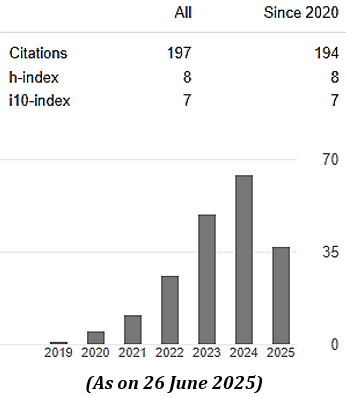A Zero-Equation Model for External Aerodynamics
Abstract
The zero-equation model (ZEM) has been generalized for aerodynamic applications by eliminating the thickness of boundary-layer (BL) dependency to construct the stress length parameter . The SED (Structural Ensemble Dynamics) postulate evaluates the using the order function based on universal multi-layer structures for wall turbulence. The SED concept is further employed to optimize the profiles of the turbulent kinetic energy and dissipation rate with turbulent BL flows. Results demonstrate that the multi-layer ZEM receives a remarkable achievement in the prediction of wall-bounded turbulence and thus, prevails over the drawbacks encountered in most algebraic turbulence models.
Downloads
References
Bradshaw, P., Ferriss, D. H., & Atwell, N. P. (1967). Calculation of boundary-layer development using the turbulent energy equation. Journal of Fluid Mechanics, 28(3), 593-616.
Cook, P. H., Firmin, M. C. P., & McDonald, M. A. (1977). Aerofoil RAE 2822: pressure distributions, and boundary layer and wake measurements. RAE, Report AR-138, AGARD, Paris.
Fang, C., & Xu, J. (2022). Extension of the KDO turbulence/transition model to account for roughness. Advances in Aerodynamics, 4(1), 2. https://doi.org/10.1186/s42774-021-00092-9
Kawamura, H., Abe, H., & Matsuo, Y. (1999). DNS of turbulent heat transfer in channel flow with respect to Reynolds and Prandtl number effects. International Journal of Heat and Fluid Flow, 20(3), 196-207. doi:10.1016/S0142-727X(99)00014-4.
Lien, F. S., Kalitzin, G., & Durbin, P. A. (1998). RANS modeling for compressible and transitional flows. In Proceedings of the summer program (Vol. 1, p. 1998). Stanford University USA.
Mansour, N. N., Kim, J., & Moin, P. (1988). Reynolds-stress and dissipation-rate budgets in a turbulent channel flow. Journal of Fluid Mechanics, 194, 15-44.
Menter, F. R. (1994). Two-equation eddy-viscosity turbulence models for engineering applications. AIAA journal, 32(8), 1598-1605.
Prandtl, L. (1925). Bericht über Untersuchungen zur ausgebildeten Turbulenz. ZAMM‐Journal of Applied Mathematics and Mechanics/Zeitschrift für Angewandte Mathematik und Mechanik, 5(2), 136-139.
Rahman, M. M., Hasan, K., Liu, W., & Li, X. (2021). Predicting Fully-developed Channel Flow with Zero-equation Model. MIST International Journal of Science and Technology (MIJST), 9:17-22; 2021. https://doi.org/10.47981/j.mijst.09(02)2021.315(17-22)
Rahman, M. M. (2023). Capturing transition and non-transition flows with a new shear stress transport model. Chinese Journal of Aeronautics, 36(3), 121-136. https://doi.org/10.1016/j.cja.2022.08.013
Rahman, M. M. (2023). Predicting transition with wall-distance-free SST k-ω model. Computers & Fluids, 250, 105704. https://doi.org/10.1016/j.compfluid.2022.105704
Rahman, M. M., Siikonen, T., (2001). An artificial compressibility method for incompressible flows. Numerical Heat Transfer, Part B: Fundamentals, 40(5), 391-409.
Rahman, M. M., & Siikonen, T. (2002). A dual-dissipation scheme for pressure-velocity coupling. Numerical Heat Transfer: Part B: Fundamentals, 42(3), 231-242.
Rahman, M. M., & Siikonen, T. (2008). An artificial compressibility method for viscous incompressible and low Mach number flows. International Journal for Numerical Methods in Engineering, 75(11), 1320-1340.
Rahman, M. M. (2021). Compromising with corrector step of SIMPLE algorithm. Mathematics and Computers in Simulation, 188, 135-163.
Rahman, M. M., Rautaheimo, P., & Siikonen, T. (1997). Numerical Study of Turbulent Heat Transfer from a Confined Impinging Jet Using a Pseudo-comressibility Method. In 2nd International Symposium on Turbulent Heat and Mass Transfer, Delft, June 9-12, 1997 (pp. 511-520).
Rahman, M. M., Miettinen, A., & Siikonen, T. (1996). Modified SIMPLE formulation on a collocated grid with an assessment of the simplified QUICK scheme. Numerical Heat Transfer, 30(3), 291-314. https://doi.org/10.1080/10407799608915084.
Rahman, M. M., Siikonen, T., & Miettinen, A. (1997). A pressure-correction method for solving fluid flow problems on a collocated grid. Numerical Heat Transfer, 32(1), 63-84. https://doi.org/10.1080/10407799708914999.
Rahman, M. M. (2020). Avoiding under-relaxations in SIMPLE algorithm. Numerical Heat Transfer, Part B: Fundamentals, 78(5), 310-329. http://dx.doi.org/10.1080/10407790.2020.1787043.
Rahman, M. M. (2022). Predicting transition with algebraic intermittency function. Physics of Fluids, 34(3), 034113. https://doi.org/10.1063/5.0077513
Savill, A. M. (1993). Some recent progress in the turbulence modelling of by-pass transition. Near-wall turbulent flows, 829-848, Elsevier Science, New York, 829-848.
Segalini, A., Örlü, R., & Alfredsson, P. H. (2013). Uncertainty analysis of the von Kármán constant. Experiments in Fluids, 54, 1-9.
Singh, J. P. (2001). An improved Navier-Stokes flow computation of AGARD Case-10 flow over RAE2822 airfoil using Baldwin-Lomax model. Acta mechanica, 151(3-4), 255-263.
She, Z. S., Chen, X., Wu, Y., & Hussain, F. (2010). New perspective in statistical modeling of wall-bounded turbulence. Acta Mechanica Sinica, 26(6), 847-861.
She, Z. S., Chen, X., & Hussain, F. (2017). Quantifying wall turbulence via a symmetry approach: a Lie group theory. Journal of Fluid Mechanics, 827, 322-356.
She, Z. S., Hu, N., & Wu, Y. (2009). Structural ensemble dynamics based closure model for wall-bounded turbulent flow. Acta Mechanica Sinica, 25(5), 731-736.
Townsend, A. A., (1976). The Structure of Turbulent Shear Flow, 2nd edition. Cambridge University Press.
Wilcox, D. C., (2006). Turbulence Modeling for CFD, vol. 2. La Canada, DCW industries.
MIJST follows the open access policy.

This work is licensed under a Creative Commons Attribution-NonCommercial 4.0 International License. This allows anyone to copy, share, distribute, and modify the work for non-commercial purposes, where the original work and source should be properly credited.















